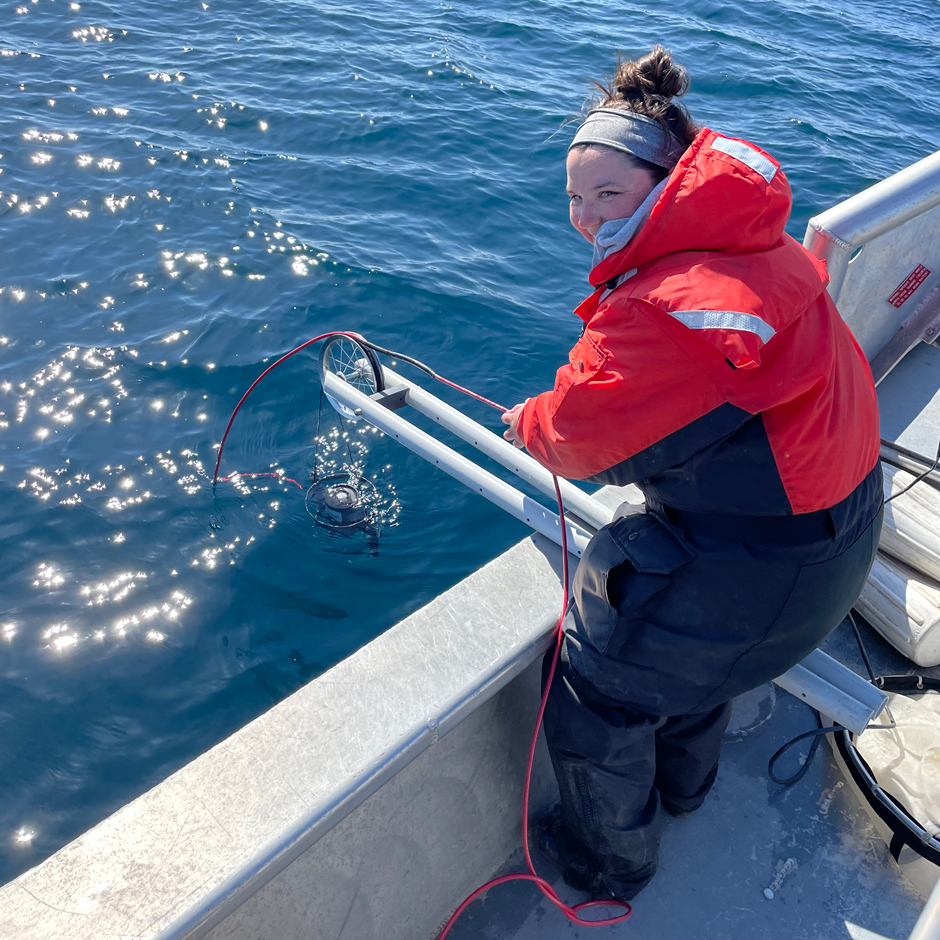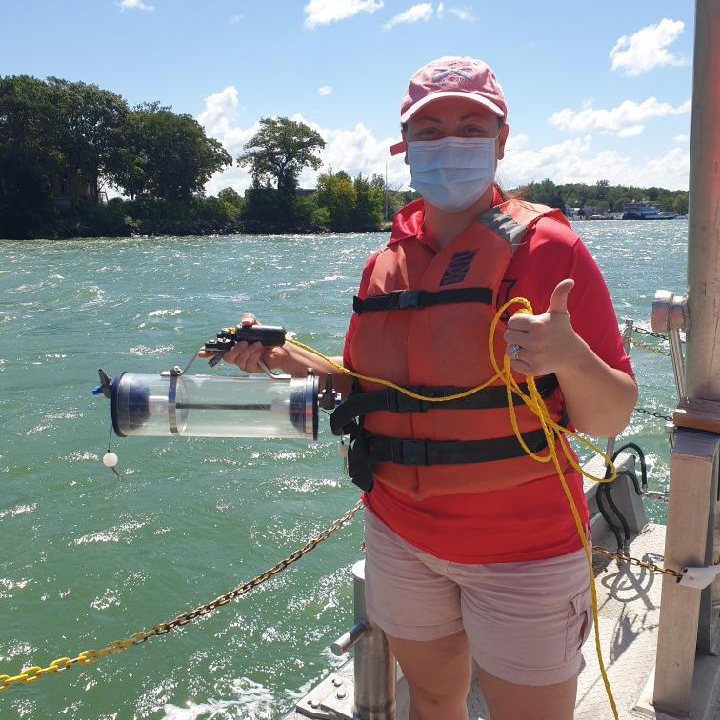Crystal Clear Problems: Impacts of Water Transparency in Aquatic Ecosystems
 PhD candidate Nicole Berry measures water transparency using an underwater radiometer. The offshore regions of Lakes Michigan and Huron are increasing in transparency. This may expose the early life stages of fish to damaging ultraviolet radiation. (Credit: Nicole Berry)
PhD candidate Nicole Berry measures water transparency using an underwater radiometer. The offshore regions of Lakes Michigan and Huron are increasing in transparency. This may expose the early life stages of fish to damaging ultraviolet radiation. (Credit: Nicole Berry)From crystal clear alpine lakes to muddy rivers and boggy swamps, water transparency is an easily observable water quality parameter to anyone who takes a few moments to peer into the (sometimes) murky depths. Water transparency varies dramatically based on the location of bodies of water among different watershed environments, but it can also change quickly due to a variety of internal and external factors.
At Miami University (OH), the Global Change Limnology Lab explores the many ways that water transparency impacts aquatic ecosystems. Operational for nearly 20 years, the lab trains undergraduate and graduate students and has conducted work from the midwest Great Lakes to Alaska, South America and New Zealand.
The Global Change Limnology Lab, headed by Dr. Craig Williamson, has carried out significant research in its time. Dr. Williamson maintains an extensive database on water transparency, with data from almost 400 lakes. He also served on the United Nations Environmental Effects Assessment Panel as an expert on the effects of UV on aquatic systems.
The lab primarily looks at the factors that control water transparency and how fluctuations in transparency affect aquatic ecosystems. With many bodies of water worldwide facing declines in populations of fish and other organisms, the lab hopes to highlight how vital understanding the effects of water transparency is for protecting these ecosystems.

PhD candidate Nicole Berry samples under ice on Lake Huron. Many coregonine fish species lay eggs in the fall that will incubate under the ice through the winter. (Credit: Nicole Berry)
Effects of Water Transparency
Biotic and abiotic factors are both affected by water transparency. Biota can be affected directly via UV radiation and indirectly due to changing abiotic conditions, which often arise externally.
“It’s a structuring factor for a lot of things,” says Erin Overholt, who received her Master of Science in Zoology from Miami University and is now the Global Change Limnology lab manager. Overholt went on to explain how water transparency influences how deep light penetrates in lakes, which in turn changes temperature, oxygen, and photosynthesis levels.
Light, temperature, and oxygen levels are all imperative to a productive aquatic ecosystem but are also extremely sensitive to changes in water transparency. “Water transparency, aside from being something that people can see and characterize as dirty or clean, also has those underlying water quality variables that it directly influences,” says Overholt.
Overholt and students in the Global Change Limnology Lab focus, in part, on how dissolved organic matter within inland lakes impacts transparency. Dissolved organic matter (DOM) is different from sediment or algae, which are considered particulate matter. DOM consists primarily of carbon and other nutrients including nitrogen and phosphorus. When DOM builds up it absorbs UV wavelengths and reduces UV transparency throughout the water column. “We’re primarily interested in UV radiation, and dissolved organic matter selectively absorbs in that wavelength range,” says Overholt. The lab has long focused on the effects of UV radiation on aquatic ecosystems and is now at the forefront of understanding the role that DOM plays in changing transparency levels.
UV Transparency and Freshwater Biota
In the same way that we can get sunburn or DNA damage from spending too much time in the sun, aquatic organisms can also experience negative impacts from UV exposure, says Overholt. The effects of changing UV radiation levels on aquatic animals, especially in early life stages, are being explored by a student within the Global Change Limnology Lab.
Ph.D. candidate Nikki Berry, along with Overholt, is working on a project studying UV transparency effects on the early life stages of fish, specifically focusing on how UV affects recruitment in the egg and larval stages. Studies have already found that as lakes become clearer, fish are exposed to more UV-B (short wavelength) radiation. While the exact mechanisms causing these declines are still unknown, the Global Change Limnology Lab hypothesizes that the effects of increased UV radiation in the early stages play a significant role in the declining recruitment of some species of young fish.
Overholt and Berry study fish found in the Great Lakes because some lakes such as Lakes Michigan and Huron are becoming more transparent to visible light, and may become more transparent to UV light as well. Overholt explains that this increase in transparency is due primarily to invasive zebra mussels that filter algae and nutrients.

With funding from the Ohio Department of Higher Education’s Harmful Algal Bloom Research Initiative, a team from Miami University is investigating the role of dissolved organic matter in controlling the frequency and toxicity of harmful algal blooms. Members of the research team sampled 24 mesocosms for eight weeks. (Credit: Erin Overholt).
While fish larvae may be directly harmed by increased water transparency, decreased transparency can indirectly harm other organisms by altering abiotic conditions. Overholt explains how increased dissolved organic matter could absorb light energy at the surface, limiting how much light travels deeper and heating the surface waters, which could provide ideal temperatures for toxic cyanobacteria.
Changes in the depth to which light penetrates also affect what can live there, what nutrients are released, and the distribution among organisms throughout the water column. When the light becomes limited at deeper depths, algae and cyanobacteria congregate at shallower depths and produce more oxygen at the surface, but reduce the light that is necessary for photosynthesis to produce oxygen at deeper depths. As the algae die they settle out, leading to hypoxic conditions deep in the lake. Overholt explains that many zooplankton and fish may be unable to tolerate these conditions and therefore move to shallower areas with higher levels of oxygen.
“Water transparency controls how much light is available within the water column,” says Overholt. “Some organisms are able to detect and avoid harmful UV radiation, so they swim away to avoid damage.” The largest migration on Earth occurs when zooplankton move from deeper water, where they spend their days, to shallower depths at night to feed. Light is a major driver of this daily migration. Similarly, algae are found where light is most optimal for photosynthesis.
An increased frequency of harmful algal blooms can also be tied to water transparency, which Overholt believes may be exacerbated by changes in dissolved organic matter. Although widely observed and known to be caused in part by excess nutrient runoff and other human activities, some of the factors that control the frequency and toxicity of these blooms are unknown.
“We’re thinking about harmful algal blooms, and we don’t know quite what controls them or what controls the toxin production that makes them harmful,” says Overholt. “Our lab is at the forefront emphasizing that dissolved organic matter is something that we need to think more about.”
Climate Change and Human Impacts
As with many water quality problems facing the world today, anthropogenic impacts are often at the root of the problem. From climate change-induced droughts that can cause lakes to become clearer, to increased precipitation events that flush dissolved organic matter, fertilizer and pollutants into the water, human activity rapidly changes water transparency.
“There’s a lot of ways that climate change interacts with the work that we do,” says Overholt, citing the connection between dissolved organic matter and water transparency and how DOM transport within a watershed changes with precipitation levels.

PhD candidate Lauren Knose collects water from Maumee Bay in Lake Erie. Western Lake Erie is plagued by harmful algal blooms. Knose’s research investigates the role of dissolved organic matter in controlling the frequency and toxicity of these blooms. (Credit: Lauren Knose)
Conclusion
While some may assume that clear lakes indicate a perfectly healthy ecosystem, the work being done by the Global Change Limnology Lab cautions people to think otherwise. “There’s a lot going on below the surface,” says Overholt. “So what your initial reaction might be to that body of water might not fully explain what is going on.”
Despite the lab work shedding light on new problems facing aquatic ecosystems, Overholt is optimistic about the future and public understanding surrounding water transparency. Overholt emphasizes that by listening to the scientists, working in citizen science groups, and taking a moment to appreciate the nature around you, all can play a positive role in fostering healthy bodies of water.




0 comments